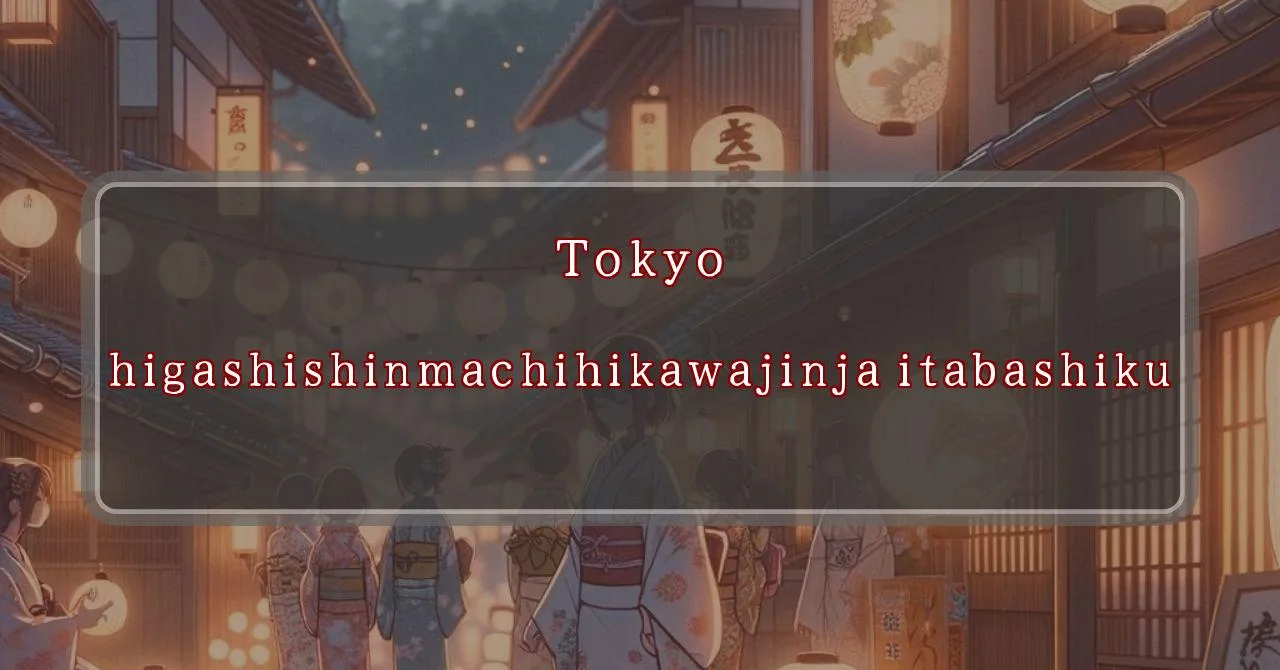Gleaming lights, divine festival
Basic Information
Higashishinmachi Hikawa Shrine is a Shinto shrine located in the Higashishinmachi neighborhood of Itabashi Ward in Tokyo, Japan. It is dedicated to the god Susanoo-no-Mikoto, the god of wind and rain.
- Address: 2-16-1 Higashishinmachi, Itabashi-ku, Tokyo 174-0074
- Phone Number: 03-3958-0216
- Access: 12-minute walk from Tokiwadai Station on the Tobu Tojo Line
- Festival Days: September 14th (Thu), 2024 (Reiwa 6)
Main Events and Attractions of the Festival
The Higashishinmachi Hikawa Shrine Festival is an annual event that takes place on September 14th. The festival features a variety of events and attractions, including:
Mikoshi Procession
A mikoshi is a portable Shinto shrine that is carried through the streets during festivals. The mikoshi at the Higashishinmachi Hikawa Shrine Festival is carried by a team of people and is paraded through the streets of the neighborhood. The mikoshi is believed to be inhabited by the god Susanoo-no-Mikoto, and the procession is a way to honor him and bring good luck to the community.
Kagura Performance
Kagura is a traditional Japanese dance and music performance that is often performed at Shinto shrines. The kagura performance at the Higashishinmachi Hikawa Shrine Festival is performed by a group of trained dancers and musicians. The performance tells the stories of the gods and goddesses of Shinto mythology, and it is a beautiful and moving experience.
Food Stalls
There are a variety of food stalls at the Higashishinmachi Hikawa Shrine Festival, selling a variety of Japanese foods, such as yakitori, takoyaki, and okonomiyaki. There are also stalls selling souvenirs and other goods.
Fireworks Display
The Higashishinmachi Hikawa Shrine Festival concludes with a fireworks display. The fireworks are set off over the shrine grounds, and they provide a spectacular light show for the festival attendees.
Blessings and Deities
The Higashishinmachi Hikawa Shrine is dedicated to the god Susanoo-no-Mikoto, the god of wind and rain. Susanoo-no-Mikoto is also known as the god of the sea, agriculture, and protection against evil. He is a powerful and important god in Japanese mythology, and he is revered by many people in Japan.
- Blessings: Susanoo-no-Mikoto is believed to bestow blessings of good luck, protection, and success to those who worship him.
- Deities: In addition to Susanoo-no-Mikoto, the Higashishinmachi Hikawa Shrine also enshrines other deities, including Amaterasu-omikami, the goddess of the sun, and Inari Okami, the god of rice and fertility.
Origin and History
The Higashishinmachi Hikawa Shrine was founded in the year 1624. It is said that the shrine was built on the site of a former Inari shrine. The shrine was originally called the Inari Shrine, but it was renamed to the Higashishinmachi Hikawa Shrine in 1872.
- Founder: The Higashishinmachi Hikawa Shrine was founded by a man named Hachirobei. Hachirobei was a wealthy merchant who lived in the Higashishinmachi area. He donated the land for the shrine and also contributed to its construction.
- History: The Higashishinmachi Hikawa Shrine has a long and rich history. It has been visited by many famous people over the years, including the shogun Tokugawa Ieyasu and the emperor Meiji.
Tips and Notes for Visitors
Here are some tips and notes for visitors to the Higashishinmachi Hikawa Shrine:
- Dress Code: There is no specific dress code for visiting the Higashishinmachi Hikawa Shrine. However, it is considered respectful to dress modestly.
- Photography: Photography is allowed inside the shrine grounds. However, it is not allowed to take pictures of the honden (main shrine building).
- Offerings: Visitors can make offerings to the gods at the shrine. The most common offering is money, but other offerings, such as food and flowers, are also acceptable.
- Ema: Visitors can also write their wishes on ema (wooden plaques) and hang them at the shrine. This is a way to ask the gods for their help and protection.
Parking Information
There is no parking lot at the Higashishinmachi Hikawa Shrine. However, there are several public parking lots nearby. The closest parking lot is the Tokiwadai Station Parking Lot, which is located a 5-minute walk from the shrine.
- Tokiwadai Station Parking Lot: This parking lot is located next to Tokiwadai Station. It has a capacity of 100 cars.
- Higashishinmachi Parking Lot: This parking lot is located a 3-minute walk from the shrine. It has a capacity of 50 cars.
- Itabashi Ward Office Parking Lot: This parking lot is located a 10-minute walk from the shrine. It has a capacity of 200 cars.
Popular Stalls and Food Carts in Recent Years
| Type of Stall | Description |
|---|---|
| Takoyaki | A staple at Japanese festivals. Characterized by a crispy outside and a creamy inside. |
| Jaga Butter | A simple yet popular snack of hot potatoes lavishly topped with melted butter. |
| Baby Castella | Small castella cakes, sweet and fluffy treats enjoyed by children and adults alike. |
| Grilled Ayu with Salt | Fresh ayu fish grilled whole with salt, a savory taste of Japanese summer. |
| Shaapin | A unique gourmet item influenced by foreign cuisine, with a chewy skin wrapping the filling. |
| Okonomiyaki | A Japanese grilled dish where you often choose your own ingredients for a personalized flavor. |
| Cotton Candy | A fluffy, sweet snack that’s extremely popular with children. |
| Chocolate Banana | A banana coated in chocolate, a fun and visually appealing dessert. |
| Kushiyaki | Various types of ingredients skewered and grilled, an easy-to-enjoy snack. |
| Yakisoba | Fried noodles mixed with a special sauce, a fast food favorite in Japan. |



